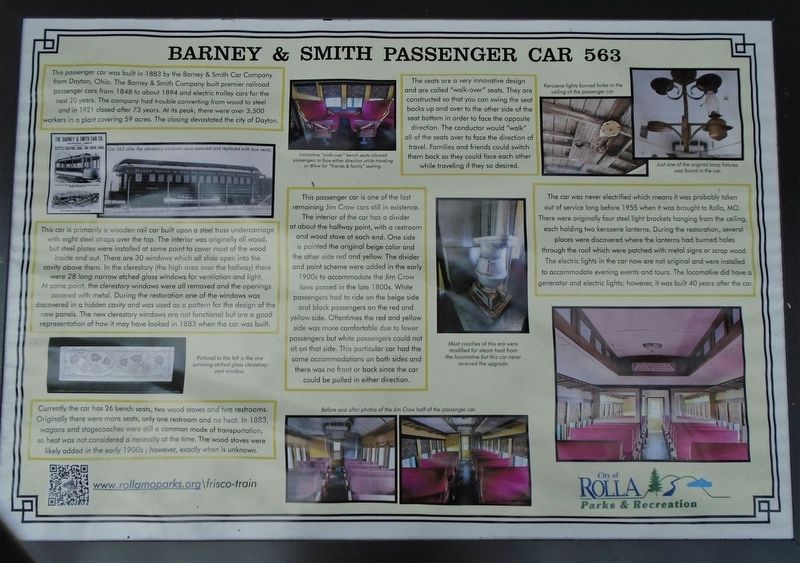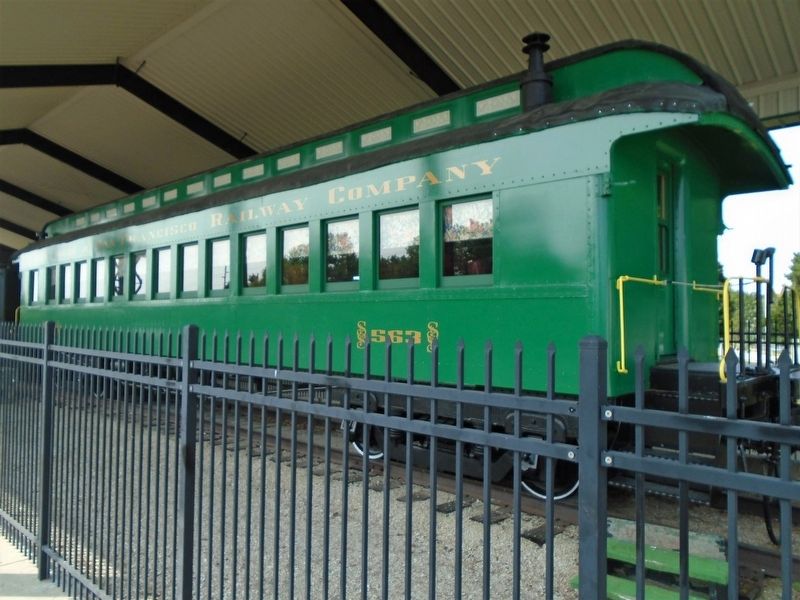Barney & Smith Passenger Car 563
This passenger car was built in 1883 by the Barney & Smith Car Company from Dayton, Ohio. The Barney & Smith Company built premier railroad passenger cars from 1848 to about 1894 and electric trolley cars for the next 20 years. The company had trouble converting from wood to steel and in 1921 closed after 73 years. At its peak, there were over 3,500 workers in a plant covering 59 acres. The closing devastated the city of Dayton.
This car is primarily a wooden rail car built upon a steel truss undercarriage with eight steel straps over the top. The interior was originally all wood, but steel plates were installed at some points to cover most of the wood inside and out. There are 30 windows which all slide open into the cavity above them. In the clerestory (the high area over the hallway) there were 28 long narrow etched glass windows for ventilation and light.
At some point, the clerestory windows were all removed and the openings covered with metal. During the restoration one of the windows was discovered in a hidden cavity and was used as a pattern for the design of the new panels. The new clerestory windows are not functional but are a good representation of how it may have looked in 1883 when the car was built.
Currently the car has 26 bench seats, two wood stoves and two restrooms. Originally there were more seats,
only one restroom and no heat. In 1883, wagons and stagecoaches were still a common mode of transportation, so heat was not considered a necessity at the time. The wood stoves were likely added in the early 1900s; however, exactly when is unknown.The seats are a very innovative design and are called "walk-over" seats. They are constructed so that you can swing the seat backs up and over to the other side of the seat bottom in order to face the opposite direction. The conductor would "walk" all of the seats over to face the direction of travel. Families and friends could switch them back so they could face each other while traveling if they so desired.
This passenger car is one of the last remaining Jim Crow cars still in existence. The interior of the car has a divider at about the halfway point, with a restroom and wood stove at each end. One side is painted the original beige color and the other side red and yellow. The divider and paint scheme were added in the early 1900s to accommodate the Jim Crow laws passed in the late 1800s. White passengers had to ride on the beige side and black passengers on the red and yellow side. Oftentimes the red and yellow side was more comfortable due to fewer passengers but white passengers could not sit on that side. This particular car had the same accommodations on both sides and there was no front or back since the car could be
The car was never electrified which means it was probably taken out of service long before 1955 when it was brought to Rolla, MO. There were originally four steel light brackets hanging from the ceiling, each holding two kerosene lanterns. During the restoration, several places were discovered where the lanterns had burned holes through the roof which were patched with metal signs or scrap wood. The electric lights in the car now are not original and were installed to accommodate evening events and tours. The locomotive did have a generator and electric lights; however, it was built 40 years after the car.
[Photo captions, clockwise from top left, read]
• Car 563 after the clerestory windows were removed and replaced with box vents.
• Innovative "walk-over" bench seats allowed passengers to face either direction while traveling or allow for "friends & family" seating.
• Kerosene lights burned holes in the ceiling of the passenger car.
• Just one of the original lamp fixtures was found in the car.
• Most coaches of this era were modified for steam heat from the locomotive but this car never received the upgrade.
• Before and after photos of the Jim Crow half of the passenger car.
• Pictured to the left is the one surviving etched glass clerestory vent window.
Erected
Topics. This historical marker is listed in these topic lists: African Americans • Civil Rights • Industry & Commerce • Railroads & Streetcars. A significant historical year for this entry is 1883.
Location. 37° 57.38′ N, 91° 45.95′ W. Marker is in Rolla, Missouri, in Phelps County. Marker is on Bardsley Road south of Arkansas Avenue, on the right when traveling south. Passenger Car 563 and marker are in Schuman Park. Touch for map. Marker is at or near this postal address: 103 East 14th Street, Rolla MO 65401, United States of America. Touch for directions.
Other nearby markers. At least 8 other markers are within walking distance of this marker. Preservation of Steam Locomotive & Passenger Car (a few steps from this marker); Engine 1501 and Passenger Car (within shouting distance of this marker); Frisco 1501 Steam Locomotive (within shouting distance of this marker); Pine Street and Downtown Rolla (approx. 0.4 miles away); "Black" USO (approx. half a mile away); Pennington-Gilbert Shoe Company (approx. half a mile away); "White" USO (approx. half a mile away); a different marker also named Pine Street and Downtown Rolla (approx. half a mile away). Touch for a list and map of all markers in Rolla.
Also see . . .
1. Engine 1501, Oil Tender & 1880s Passenger Car. (Submitted on October 4, 2020, by William Fischer, Jr. of Scranton, Pennsylvania.)
2. Coronavirus Shutdown Led To Restoration Of A Train In Rolla (St. Louis Public Radio, 2020). (Submitted on October 4, 2020, by William Fischer, Jr. of Scranton, Pennsylvania.)
3. A History of the Barney & Smith Car Company (H. M. Estabrook, 1911). (Submitted on October 4, 2020, by William Fischer, Jr. of Scranton, Pennsylvania.)
Credits. This page was last revised on October 4, 2020. It was originally submitted on October 3, 2020, by William Fischer, Jr. of Scranton, Pennsylvania. This page has been viewed 355 times since then and 34 times this year. Photos: 1, 2. submitted on October 4, 2020, by William Fischer, Jr. of Scranton, Pennsylvania.

